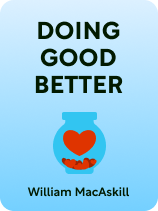

This article is an excerpt from the Shortform book guide to "Doing Good Better" by William MacAskill. Shortform has the world's best summaries and analyses of books you should be reading.
Like this article? Sign up for a free trial here.
Are you looking to make a real difference in the world? Do you want to maximize your impact on society?
William MacAskill’s book Doing Good Better explores the concept of effective altruism. It offers practical advice on how you can use your resources to help others most efficiently. MacAskill draws from his experience to present compelling arguments for maximizing your charitable efforts.
If you’re interested in learning how to make your time and money count, read on for our overview of this book.
Doing Good Better Book Overview
Given the many formidable problems plaguing the world—like poverty, food insecurity, and climate change—it’s tempting to think that no lone individual can make a difference. But, according to philosopher and public intellectual William MacAskill, that line of thinking is mistaken. In his book Doing Good Better (2015), MacAskill argues that each of us can save hundreds of lives worldwide by maximizing the good we do for others. In particular, he defends effective altruism—the movement focused on doing the most good for others with our resources—and shows how to spend our time and money to help those in need.
(Shortform note: In addition to MacAskill, Oxford philosopher Toby Ord was one of the architects of the effective altruism movement. However, the most notable advocate of effective altruism is philosopher and public intellectual Peter Singer, whose book The Life You Can Save is a classic treatise outlining the key tenets of effective altruism.)
As one of the co-founders of Giving What We Can, a nonprofit aiming to make charitable donations more common and more effective, MacAskill has years of experience as one of the architects of the effective altruism movement. Moreover, as an associate professor of philosophy at the University of Oxford, MacAskill brings rigorous, empirically driven reasoning into his arguments throughout Doing Good Better.
We’ll first focus on the principles behind effective altruism. Then, we’ll see how to apply these principles in practice, from deciding which career to pursue to which problems to address and which charities to fund.
The Principles Behind Effective Altruism
To set the stage for effective altruism’s practical implications, we’ll first examine its theoretical foundations. We’ll discuss the three principles that lie at the heart of effective altruism: First, that our actions should maximize the net benefit to humanity; second, that we should reason counterfactually to decide which actions really make a difference; and third, that we should calculate the expected value of different actions when their consequences are unclear.
Principle #1: Maximize the Net Benefit to Humanity
First, MacAskill points out that each of us is faced with decisions about how to spend our time and money—should we splurge on a nice dinner, or eat at home and donate the money that we saved? Should we use our time to volunteer at a soup kitchen or an afterschool program? To answer these questions, he suggests that we consult the first principle of effective altruism: Perform the action that maximizes the net benefit to humanity.
To see how intuitive this principle is, consider wartime doctors who are forced to decide which patients to treat. Inevitably, they can’t treat everyone—some patients have fatal injuries beyond treatment. Further, other patients deserve priority treatment—if forced to choose between caring for one patient who will die without treatment, and five with minor injuries who will survive regardless, it makes sense to treat the former. In other words, these doctors try to treat patients in a way that maximizes lives saved since their resources are limited.
MacAskill suggests that, analogously, we should use our resources to maximize net good. For example, although we aren’t dividing our time between wartime patients, we do divide our time between different pursuits; some of us might choose to volunteer at a blood drive, while others might choose not to volunteer. Likewise, some of us might choose to spend our money donating to international charities, while others choose to spend it on luxury cars. In both cases, our guiding principle should involve maximizing the total good we’re doing for humanity.
How to Use Quality-Adjusted Life Years to Maximize the Good to Humanity
Nonetheless, MacAskill acknowledges that it’s difficult to measure the impact of different actions—for instance, how should we determine the impact of funding a charity that distributes malaria nets versus one that funds sex education programs? To do so, he recommends that we estimate the quality-adjusted life years (QALYs) associated with a given action to inform our decision.
QALYs, MacAskill relates, refer to a combination of the time that we can extend someone’s life multiplied by the quality of that life during that time (typically measured on a subjective scale of one to 10). For example, suppose that medication for AIDS could increase someone’s quality of life from a three out of 10 to an eight out of 10 over five years. Then, this medication would have a net increase of five out of 10 (50%) times five years, meaning it yields 2.5 QALYs.
MacAskill says that by estimating the QALYs associated with different donations and actions, we can estimate which yields the greatest benefit. For example, imagine that you’re deciding between donating $5,000 to an organization fighting homelessness and donating $5,000 to an organization that funds cochlear implants for deaf people. You might estimate that $5,000 donated to the organization for homelessness will yield 0.3 QALYs times two years (0.6 total QALYs), while $5,000 donated to the organization for cochlear implants will yield 0.2 QALYs times six years (1.2 total QALYs). In this case, you should donate to the organization for deaf people, as it delivers a greater increase in QALYs.
Principle #2: Assess the Counterfactual
Although estimating the benefit of our actions is an important aspect of effective altruism, it isn’t the only one. MacAskill argues that effective altruism also requires assessing the counterfactual—that is, determining what would have happened if we had taken a different course of action.
Counterfactual reasoning is common in everyday life, writes MacAskill. For example, if you spent $40 getting drinks with friends, you might reason that you could’ve instead put that money toward a monthly gym membership. Likewise, in the context of effective altruism, you might reason that if you hadn’t given your money to charity A, you could have instead given it to charity B, or if you hadn’t volunteered at organization X, you could have instead volunteered at organization Y.
The upshot is that you should perform the action that maximizes your benefit relative to the counterfactual. For example, imagine that you’ve decided to become a doctor out of a desire to help needy patients. Although this might seem like an effective way to help others, MacAskill points out that it’s actually not especially effective, because if you hadn’t become a doctor, someone else would have simply taken your place. In other words, you aren’t treating patients who otherwise would receive no treatment; you’re treating patients who would have otherwise received treatment from someone else.
By contrast, if you became a doctor to donate most of your salary to charity, that would fare better under the counterfactual test—after all, the other person who would’ve gotten your job as a doctor likely wouldn’t have donated as much.
Principle #3: Calculate Expected Value
The principles of maximizing the net benefit and assessing the counterfactual both assume that you can predict the consequences of every course of action. But MacAskill points out that this assumption is often false—if you go into cancer research, for example, it’s impossible to know whether your research will yield a massive breakthrough. For this reason, he recommends that you calculate the expected value of your possible actions to decide which to perform.
MacAskill explains that the concept of expected value is standard in betting, where it allows bettors to decide which bets to take. For example, imagine that someone offers you a bet on the 50% chance that a coin lands on heads—if it does, they’ll pay you $200, and if it doesn’t, you pay them $100. To calculate the expected value, you simply multiply the outcomes by the probability that they occur, then subtract the expected money lost from the expected money won. In this case, your expected value is ($200 x 0.5) – ($100 x 0.5) = $50. In other words, taking the bet nets you an expected value of $50, so you should take it.
In the context of effective altruism, calculating expected value can help you decide between risky careers. For example, imagine you’re choosing between becoming a cancer researcher and a climate change researcher. You might think that, if you become a cancer researcher, your chance of a massive breakthrough (say, one that yields one million QALYs) is about 1%, and the other 99% of the time you’ll have a modest career that saves 1,000 QALYs. By contrast, you might think that if you become a climate change researcher, there’s a 2% chance of a massive breakthrough (say, one that saves 600,000 QALYs), but the other 98% of the time you’ll make no progress (0 QALYs).
First, the expected value of becoming a cancer researcher is (0.01 x 1,000,000 QALYs) + (0.99 x 1,000 QALYs) = 10,990 QALYs. On the other hand, the expected value of becoming a climate change researcher is (0.02 x 600,000 QALYs) + (0.98 x 0 QALYs) = 12,000 QALYs. So, this (oversimplified) calculation would suggest that it’s better to become a climate change researcher, since that route has a higher expected value.
The Practical Implications of Effective Altruism
We’ll discuss how effective altruism principles can help you make three key decisions—which career to pursue, which problems to address, and which charities to fund.
Determine Which Career Path to Take
According to MacAskill, the first decision that effective altruism can inform will determine how you spend 80,000 hours of your life—namely, which career you should pursue. He argues that, regardless of whether you decide to earn to give or work directly for altruistic causes, you should assess future careers along three considerations: How well do you personally align with the career? What will your immediate impact be? And what’s the long-term impact of your career?
Consideration #1: Alignment
First, MacAskill contends that careers that offer strong personal alignment are most conducive to effective altruism. He explains that, in careers that suit you well, you’ll be more likely to work productively and more resistant to burnout, meaning your long-term impact will be greater.
To find such careers, MacAskill recommends that you focus less on nebulous notions like your “calling” or “passion” and instead seek out careers with features that, according to research, are predictive of job satisfaction. For example, you should seek out careers that offer you a sense of autonomy over your work and allow you to perform an array of interesting tasks. Moreover, he says, research suggests that work with a tangible, positive impact on other people is more likely to satisfy you.
Consideration #2: Immediate Impact
Next, MacAskill writes that you should consider the immediate impact that you’ll have on the job. He maintains that this immediate impact occurs in two primary ways—first, via the actual labor that you perform on the job, and second, via the money you can earn and donate to worthy causes.
Regarding your actual labor, if you pursue a career at an altruistic organization then you can directly improve the lives of those around you. However, MacAskill warns that you have to remember to assess the counterfactual to determine your actual impact—you don’t merely need to do good work in your job, but rather better work than the person who would have gotten your job in your place. For example, in a social work organization with sufficient staffing, your job would’ve likely been filled by another competent social worker had you declined, meaning your net impact might actually be fairly small.
MacAskill says that earning to give, on the other hand, passes the counterfactual test—because few individuals donate a significant amount of money, the person who would have gotten your job in your place likely wouldn’t have donated significantly. For example, if you’re a corporate lawyer who chooses to donate (say) $100,000 annually, it’s likely that the person who would’ve taken your job had you worked elsewhere would not have donated as much.
Consideration #3: Long-Term Impact
Finally, MacAskill recommends that you assess the long-term impact of your job, specifically in terms of the skills and knowledge that you’ll develop. He points out that, in certain jobs, the organizational experience you gain can prove valuable if you decide to transition to a different career later in life. For instance, although working in business directly out of college might feel less altruistic than joining a non-profit, the experience you gain managing employees can pay dividends if you decide to shift to a non-profit later in your career.
Determine Which Problems to Address
MacAskill writes that just as effective altruism can help you decide on a career, it can also inform your decision of which problems to address—whether directly, via working for an organization focused on a specific cause, or indirectly, via donating money to an organization that focuses on a specific cause. He contends that you should assess causes via three dimensions: What is the magnitude of the problem? How feasible is solving the problem? And how underappreciated is the problem?
Dimension #1: Magnitude
To start, MacAskill explains that we should focus on problems of greater magnitude, all else being equal. In other words, we should tackle issues that have the largest impact on well-being worldwide. For example, researchers estimate that cardiovascular diseases cost 393 million QALYs annually, whereas mental health disorders cost 125 million QALYS annually. Consequently, MacAskill would suggest that we should prioritize addressing cardiovascular diseases instead of mental health disorders, holding all other factors equal.
Dimension #2: Feasibility
Additionally, MacAskill clarifies that it’s better to focus on problems that we can feasibly solve, rather than those that are less solvable. For example, if it turned out that cardiovascular diseases were significantly more difficult to research, whereas mental health disorders could be treated easily, we should focus on treating mental health disorders—even though it’s a smaller magnitude problem.
Dimension #3: Visibility
Finally, MacAskill argues that you should focus especially on overlooked causes rather than well-known causes. After all, well-known causes (such as climate change) receive more attention, meaning that your donation or labor won’t make a huge difference—even if you don’t donate, the charity will have sufficient funding, and even if you aren’t a climate change researcher, there will likely be sufficient researchers. By contrast, less prominent causes (such as anti-malaria initiatives) pass the counterfactual test, because they will be materially less effective without your donation or direct labor.
Determine Which Charities to Fund
For those who choose to pursue high-paying careers so that they can earn to give, MacAskill notes that the final decision is which charities to fund. To find the charities most worthy of your donations, he recommends asking three questions: How cost-effective is the charity? How strong is the evidence? And is the charity underfunded?
Question #1: How Cost-Effective Is the Charity?
According to MacAskill, the pivotal factor when assessing a charity is its cost-effectiveness—that is, roughly how many QALYs are saved per dollar donated to the charity?
To answer this question, MacAskill recommends that you first find out what exactly your donation purchases. For example, if you were donating to a charity that provides Covid-19 vaccines in developing countries, you might find out that (say) a $1,000 donation can purchase 200 vaccines. Next, you need to assess roughly how many QALYs your donation saves (for most major charities, this information should be available via public studies and models). For example, you might determine that one Covid-19 vaccine saves (on average) 0.5 QALYs, meaning that your $1,000 donation of 200 vaccines saves 100 QALYs—$10 per QALY.
Question #2: How Strong Is the Evidence for the Charity?
Next, MacAskill advises assessing the evidence of a charity’s effectiveness so that you can know how confident to be about it. In this regard, he points out that peer-reviewed academic publications—especially meta-studies reviewing multiple studies—are the gold standard. Programs organizing direct cash transfers to individuals in developing countries, for instance, have been rigorously tested and found to be highly effective. So, even if one charity seems like it’s slightly less cost-effective than another, that consideration can be outweighed if that same charity has much more rigorous evidence backing its effectiveness.
Question #3: Is the Charity Underfunded?
Finally, MacAskill writes that you should figure out whether the charity is underfunded, since many of the most cost-effective charities already have sufficient funding (meaning that additional donations deliver less bang for their buck). He says that, to find out which charities need further funding, you can consult GiveWell—a nonprofit dedicated to ranking the most effective charities to donate to every year.

———End of Preview———
Like what you just read? Read the rest of the world's best book summary and analysis of William MacAskill's "Doing Good Better" at Shortform.
Here's what you'll find in our full Doing Good Better summary:
- How you can save hundreds of lives by being a good person
- The principles behind the effective altruism movement
- How to determine which charities are worth funding






